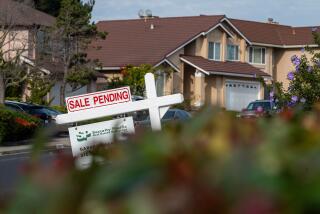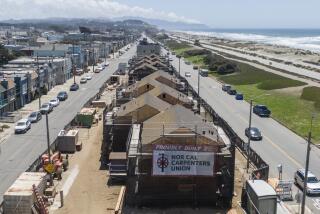8% Fall in Home Sales Is Expected
U.S. sales of new and existing homes will fall 8% this year as rising prices squeeze more people out of the real estate market, according to a forecast released Monday by Freddie Mac.
Sales will decline to 6.9 million from 7.5 million last year, McLean, Va.-based Freddie Mac, the second-largest U.S. mortgage company, said. It would be the first year since 2003 that sales were below 7 million.
Rising prices and higher mortgage rates are putting homes out of the reach of more families, Frank Nothaft, Freddie Mac’s chief economist, said in the report. Areas such as California, where job growth is increasing, have seen the biggest price gains. In the Midwest, where fewer jobs are being created, price appreciation has been slower.
“The challenge for some families is to find a good job and affordable housing in the same location,” he said. “The lingering question is whether affordability will increase in the West and job creation will return to the Midwest.”
The West Coast added 610,000 jobs in the year through February, while the Midwest added 224,000 jobs, with losses in Michigan and Ohio, Nothaft said.
West Coast home prices grew 19% in the fourth quarter of 2005 from a year earlier, compared with a gain of 6.8% in the Midwest, according to the latest data from the Office of Federal Housing Enterprise Oversight.
Nationally, home prices probably will gain 8.7% in 2006, slowing from a 13% pace in 2005, Freddie Mac said. That would be the slowest growth rate since 2003, when home prices rose 8%.
Freddie Mac’s monthly forecasts don’t provide an estimate for median home prices. Fannie Mae said in a March 22 report that the median for an existing single-family house would be $213,200 this year.
The average rate for a 30-year fixed mortgage will be 6.4% this year, rising from 5.9% in 2005, Nothaft said. The average rate for a 30-year mortgage that adjusts annually will be 5.5% in 2006, rising from 4.5% last year, he said.
Single-family mortgage lending will fall 13% to $2.46 trillion this year as higher mortgage rates damp demand for loan refinancing, according to the forecast.
In 2003, when the average U.S. rate for a 30-year fixed mortgage reached a four-decade low of 5.21%, mortgage lending rose to a record $3.86 trillion, according to Freddie Mac.
More to Read
Inside the business of entertainment
The Wide Shot brings you news, analysis and insights on everything from streaming wars to production — and what it all means for the future.
You may occasionally receive promotional content from the Los Angeles Times.










